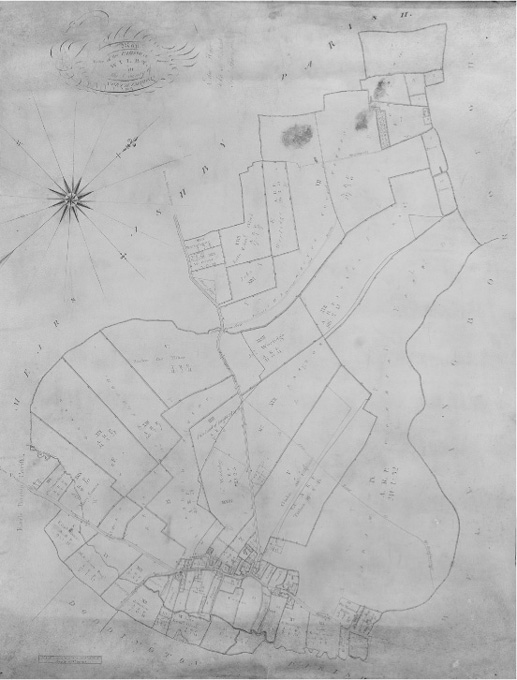

LAND RIGHTS AND THE AGRARIAN REVOLUTION
The enclosure of land transformed the English countryside, fundamentally altering the nature of farming and creating a patchwork of hedgerow-bordered fields that became the familiar face of the landscape for most of the nineteenth and twentieth centuries.
Traditionally, the countryside was farmed in open fields in which villagers grew produce in their own, often widely dispersed, strips, which allowed cottagers to engage in subsistence farming. All tenants enjoyed the right to graze whatever livestock they might have on common pasture. In consequence, herds intermingled.
This was an inefficient form of farming. Indeed, the survival of mixed-use land, subject to the rights of so many individuals, undermined any return on investment a landowner might seek to make by improving its quality. Small cultivators were far less likely to have the resources necessary to drain land. Tellingly, much land was left uncultivated. In an effort to extract better value from the soil, enclosure involved withdrawing community rights to common pasture and consolidating strips into single ownership fields that could be hedged or fenced off for private use.
When the first enclosures of common land took place in the thirteenth century, there was still sufficient common pasture to satisfy the needs of the whole village. Indeed, legislation sought to ensure that enclosure did not go so far as to wipe out access to communal grazing. A far greater assault on traditional methods came in the fifteenth century, when manors, keen to meet the growing demand for wool, pushed on with the enclosure of large-scale fields for sheep pasture. Depleting common pasture created unrest and an increasing numbers of dispossessed vagrants. Legislation followed no consistent path during this period, sometimes supporting, at other times hindering, the process according to the perceived economic circumstances of the moment. Nonetheless, there was a tendency towards trying to limit enclosure and soften the consequences for its victims, especially in areas of traditional mixed husbandry. During the seventeenth century, however, Parliament effectively gave up trying to prevent the process.
Nonetheless, open fields were still prevalent during much of the eighteenth century. It was mostly in the enclosed areas, however, that improvements became viable and where land drainage and strict crop rotation heralded an agrarian revolution. The increasing cultivation of root crops such as turnip provided forage for the hardier and heavier livestock being produced by selective stock-breeding. New breeds of sheep became worth eating, as well as merely shearing.
Across England the pace of enclosure slowed during the first half of the eighteenth century before picking up again after 1750. In seeking to prevent disputes, Parliament was asked to legislate approval for each application for enclosure. This was generally granted when the proposal had the support of three-quarters of the landholders affected. Commissioners duly surveyed and apportioned the land in a manner they deemed equitable, and the dispossessed were compensated. To this approach, there were two major objections – that the process was costly and that the compensation received by those deprived of their common rights was often inadequate.
By the end of the eighteenth century, the movement for ‘improvement’ was again in full swing, burdening Parliament with a surge of applications for legislation. Westminster passed almost four thousand enclosure acts between 1750 and 1810, covering about 20 per cent of the land of England and Wales, with the Midlands a particularly intense area of activity. It was to simplify the procedure, reduce costs and speed the process that in 1801 the General Enclosure Act – then known as the ‘Inclosure (Consolidation) Act’) – was passed. It established a template for the drafting of suitable legislation. In this it was successful, and the transformation was largely complete by the time a further General Enclosure Act in 1845 drew together all the individual grants in an annual act. By comparison, enclosure was still in its relatively early stages in the rest of Western Europe and had scarcely begun in Eastern Europe.
The overall social and economic consequences of enclosure were hotly contested at the time and continue to divide historians now. It would be surprising if such a change, carried out over so long a period and over such varied terrain, produced consistent results. Generally though, it suited the interests of landowners. Yet the nature of land redistribution can be misunderstood. The average farm in the early nineteenth century was still relatively small. Even the effects on the cottager, dispossessed of his common grazing rights, were mixed.

1801 ‘inclosure map’ of the Northamptonshire parish of Wilby. The area is now on the outskirts of Wellingborough.
In the short term, though, it was cottagers who appeared to have lost out. They were faced with the choice of either staying on, reduced to the status of hired hands, or turning their backs on the land in search of work in the towns and cities. But these were not invariably unfortunate consequences. Enclosure – married to other agricultural improvements – improved yields. It made food more plentiful and cheaper. In this light, the declining numbers engaged in subsistence farming may be viewed as a positive consequence rather than a sign of harmful effects. The surge in agricultural productivity freed labourers to seek more remunerative work in the towns and cities, providing, in turn, the workforce that made the Industrial Revolution possible and Britain the ‘workshop of the world’, a status that ultimately raised living standards far beyond what previous generations could have imagined possible.
